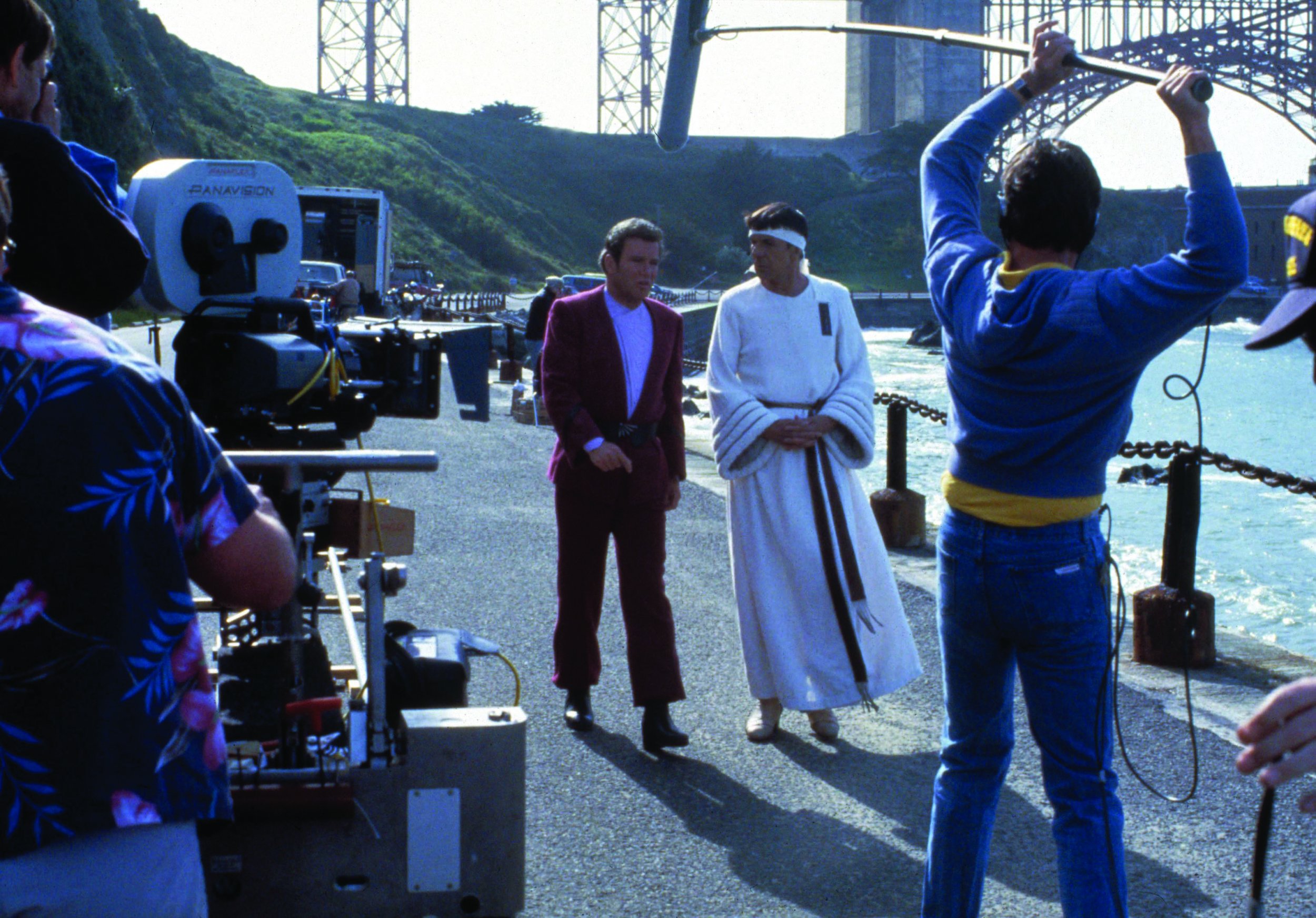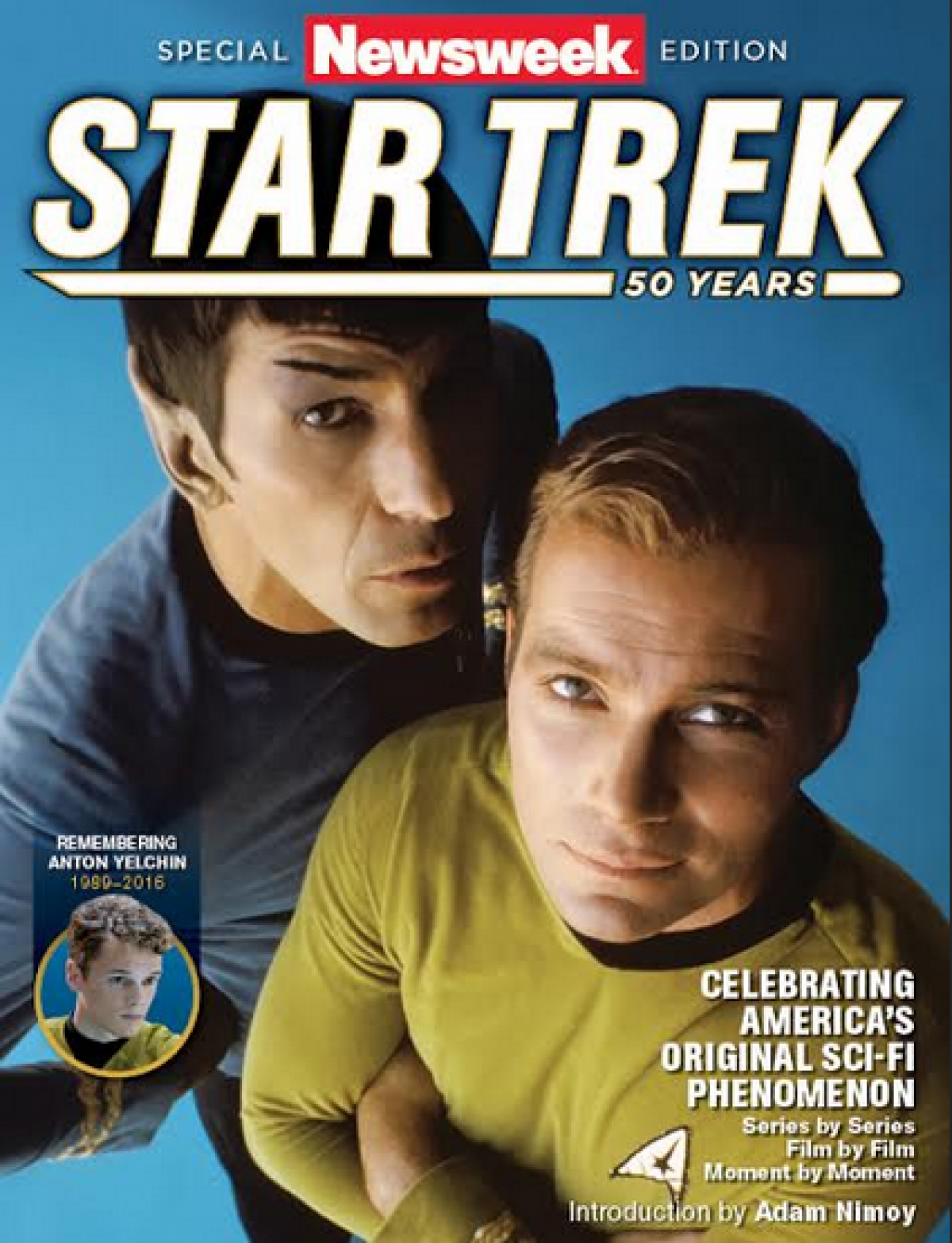
The following is an excerpt from the Newsweek archive, December 22, 1986, by Charles Leerhsen with Patrick McAlevey, Janet Huck, David Gates and Peter McKillopand. This article is featured in Newsweek's Special Issue Star Trek 50 Years: Celebrating America's Original Sci-Fi Phenomenon, by Issue Editor Tim Baker.
Hang on: You are being beamed to one of those Star Trek conventions, where grown-ups greet each other with the Vulcan salute and offer in reverent tones to pay $100 for the autobiography of Leonard Nimoy. The feature speaker: Majel Barrett, who played Nurse Chapel in the old TV series (1966–69); she also happens to be the wife of the Great Bird of the Galaxy, Mr. Star Trek creator himself, Gene Roddenberry. To an audience that has just listened, raptly, to a guy who grinds out quickie paperbacks filled with Trek trivia, she ranks as a major celebrity—and an eyewitness to some important history. For Barrett was there when the makeup men labored to get Leonard (as he's known in "fandom") just the right shade of green; and she can tell about—"Oh, you know," she says, "all the old stories that I know you've heard before." But there's no need to apologize for that here. No, her talk fairly transports the Trekkies who love nothing more than to watch the same 79 installments over and over and over and….
THEORY ONE: (as to why Star Trek has—as they say on the planet Vulcan—lived long and prospered)
Like music, it appeals to man's love of repetition. The same characters do basically the same thing in each show; and the shows get repeated and….
Barrett now segues into the question-and-answer period. "I didn't really come to talk," she explains. "I came to listen." Hands shoot up throughout the hotel ballroom. "You," Barrett says, pointing toward the rear. "With the hat."
Suddenly the room sounds like something out of the episode "Journey to Babel." Four or five Trekkies are standing and talking at the same time. Something about a Star Trek comic book; something else about William Shatner's supposedly galaxy-sized ego; something, too, about—what's that? Spock possibly fathering a…what? By whom? Geez, it's hard to hear through these pointy plastic ears!
It's also hard to imagine why Barrett would say, "You with the hat," when so many of the hard-core Trekkies tend to be the kind of people who hunker with their heads covered (earflaps down, Mr. Sulu) just waiting for the blizzard of Enterprising things to come. This is, as Barrett herself says, "the most exciting time in Star Trek history." A new TV series, tentatively titled Star Trek: The Next Generation, is in the works and could possibly be on the air by next fall. [Editor's Note: The Next Generation indeed appeared on screens in September 1987, right on time.] The pilot for The Original Series—rejected by NBC as being too cerebral for the I Dream of Jeannie generation—has just become available in video stores. (Titled "The Cage," it features Jeffrey Hunter in the captain's role.) And then, of course, there is Star Trek IV: The Voyage Home, the blockbuster hit movie now at your local theater. "How many have seen it two times?" Barrett asks. "Three times? Four? Oh, that's fantastic. I just know we're headed into a great time for Star Trek."
THEORY TWO:
People like its message of hope and reassurance about the future. After all, the Earth made it to the 23rd century, right? Of course a lot of people couldn't just stand around with their phasers cocked, waiting for this new golden age to arrive. Ever since The Original Series went into syndication, fans have been forming clubs such as Starbase Houston, a group of about 100 adults who have their own flag, jackets and anthem. Then there's Amherst's Star Trek Welcommittee, headed by Shirley Maiewski, a 66-year-old bookstore worker ("Everybody calls me 'GrandmaTrek'"). She has a Klingon warship hanging from her rec-room ceiling and can help you find out what three combinations Captain Kirk used to open his safe. Some people have laced the Star Trek motif through the most personal parts of their lives. Houston's Ray Tanyer, 43, went last summer from being a closet Trekkie to Disneyland, where he had a Star Trek wedding; he and a daughter from a previous marriage dressed as members of the Enterprise crew while his bride, Holley, wore pointy ears and adopted the Vulcan name "T'Pari."
THEORY THREE: (proposed by William Shatner)
Some of these people are insane. Aye-Aye, Captain. But it can't be kooks alone who are keeping the show going on 145 independent TV stations, where it ranks—after all these years—as the top-rated, non-network hour. Nor are there enough full-time Trekkies in the universe to account for the first three Star Trek movies generating a total of $250 million in box-office receipts, or for Paramount's report of a nearly $39 million take after the first two weeks of number IV, which looms as the biggest Trek feature ever: On the night it opened more than 1 million people saw the story of Kirk, Spock and their crew trying to save the world by transporting a pair of 20th-century humpback whales back to the future. And isn't a mass market implied by the presence of all those Trek-oriented games, greeting cards, model kits and—who knows what's next, maybe Frederick's of Hollywood beam-'em-up bras? "It's only at first glance," says Kerry O'Quinn of Starlog magazine, "that the Trekkers may seem nerdy."
And upon closer inspection?
Well, actually, it's a matter of pulling back to get a broader view until you see that…Mr. Chekov, we've been sucked into the mainstream! "[The movement]," says O'Quinn, "is everyone from grandmothers to punk rockers." Eddie Murphy is a Trekker (he would have appeared in movie IV, says Nimoy, if The Golden Child hadn't loomed as a better career move)—and so is Laurie Keeper of Starbase Houston (who surveyed about 100 female fans and found "a lot of overweight women, a lot of divorced and single women"). Not long ago Star Trek was dismissed as cult TV. But what kind of cult encompasses both leading men and lonely ladies? Clearly, the one that outgrew the pop and seeped into every corner of the culture. Consider that in 1976 NASA named its experimental space shuttle the Enterprise; by 1986 "Beam me up, Scotty" had become a catchphrase among crack users.
But if Trek references are everywhere, the marketing guys have homed in on those most likely to express their Trekker leanings by making a purchase. "It's the baby boomers who will lead Star Trek into its third decade," says convention promoter Adam Malin. He isn't the first to figure out that if the Trek actors are getting jowly and gray—or in the case of Shatner, curiously smooth skinned and hairy—their followers must be also. The Hamilton collector series has brought out a series of expensive Star Trek gift plates; and next February, Aberdeen Manufacturing will introduce a line of bedspreads and shower curtains aimed at the series' aging audience.
Paramount, which owns the title and the characters, is somewhat nervous about Star Trek becoming a mature industry. None of the original crew members will be used in the new TV series, which will feature a younger bunch of actors cavorting on a souped-up starship. The irony in this move, though, is that the studio's Trek IV windfall can be traced directly to director Nimoy taking the series back to its 1960s roots. Spock—who died in number II (of screenwriter desperation) and wasn't revived until the end of III—has returned to the Federation full time, and this makes all the difference in the universe. Suddenly, Shatner's energetic, emotional Kirk has a kind of (half) human backdrop: The audience can see him better than it has in years. All those beloved references to the half-Vulcan's logical lifestyle can be drawn out again and admired. But best of all, Spock's presence resurrects the gentle feud between him and Dr. Leonard (Bones) McCoy (DeForest Kelley). "My God," Bones says to his old shipmate, who still seems spaced out by the one-two punch of mind-meld and death he experienced in Trek III. "You really have gone where no man has gone before."
Nimoy, who directed Trek III "with training wheels on," this time does it with flair—and the scenes featuring himself and Kelley are among his favorites. "When those two guys walk off," he says, "you can see 20 years of working together. It comes off the screen at you." Shatner, who has expressed bitterness in the past about not sharing in the reported $500 million or more that Trek has generated for Paramount, seems caught up in the enthusiasm. "We're after a larger audience now," he says. "We're after people who haven't seen Star Trek—and we're learning what the ingredients are. The interplay of the characters is an important aspect."
THEORY FOUR:
People like the realistic "family" feeling that permeates the flight deck. It's a high-tech Honeymooners—but there is a similarity to Archie Bunker's household here, too: What looks like a dramatic situation often is, just below the surface, a lesson in liberalism.
Not only did Spock come back for this one, he brought that old times-they-are-a-changin' mood with him. The TV episodes, which ran during the Vietnam War's most bitter years, usually came with their own (telegraphed) message. In one called "The Day of the Dove," an alien which feeds on hatred provokes hostilities between the Enterprise crew and the Klingons—until everyone gets wise and laughs it out of existence. "Let That Be Your Last Battlefield" features an obviously absurd rivalry between a space race that is white on the left side and black on the right, and another in which those colors are reversed.
THEORY FIVE:
The series plays into our nostalgia for the burning issues of the '60s. In Trek IV we're told yet again to wake up before it's too late—and you can almost hear the strawberry alarm clocks ringing. At the start, an alien probe starts vaporizing Earth's oceans, but only because it wants to communicate with a whale that 20th-century man had foolishly hunted into extinction. The solution? A little time-travel music, please, and the crew is heading toward present-day San Francisco, a "primitive and paranoid culture," Spock explains. Once they land, the plot moves along crisply, with still more smile-lines about Spock's not being able to tell a lie and Chekov's continuing inability to pronounce the word "vessel." These bits of Star Trek are the stuff of which fanclub symposia are made. And yet, says Nimoy, here, as in the TV show, they've almost always been added as a last-minute ingredient to spice up a dull portion of the plot. "You have to understand," Nimoy says, "when we did the TV series we did it down and dirty."
Shatner, who will direct the next Trek film, wants to go even further in that direction. "I didn't take a swing [in Trek IV]," says the man who believes that "some of our best episodes were action-adventure." There was, he says, "quite a range of stories in the TV series and there's no reason that can't be brought out in the films as well."
This article was excerpted from Newsweek's Special Edition—Star Trek 50 Years: Celebrating America's Original Sci-Fi Phenomenon, by Issue Editor Tim Baker. For more about the history of the federation and the upcoming movie—Star Trek Beyond, pick up a copy today.

Uncommon Knowledge
Newsweek is committed to challenging conventional wisdom and finding connections in the search for common ground.
Newsweek is committed to challenging conventional wisdom and finding connections in the search for common ground.
About the writer
To read how Newsweek uses AI as a newsroom tool, Click here.








